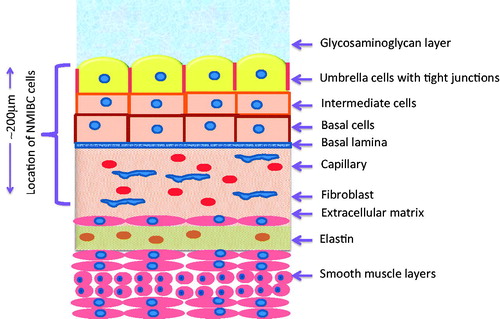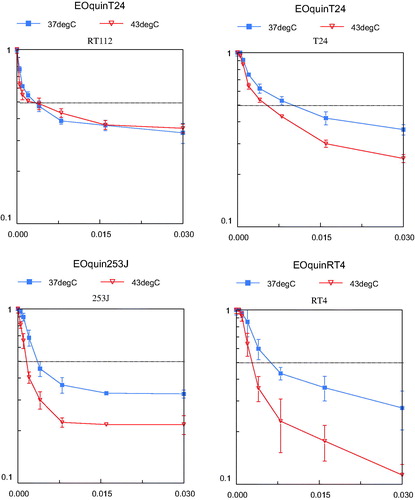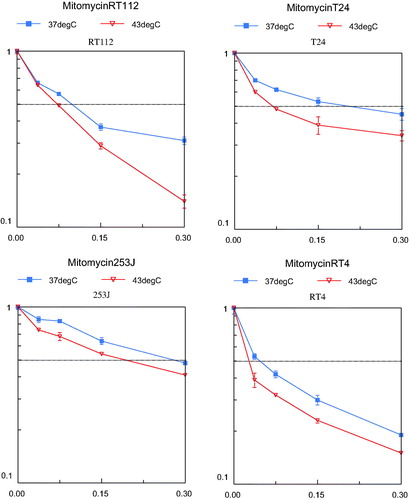Figures & data
Figure 1. Structure of bladder wall. This wall is very impermeable to water. The umbrella cells contain a high percentage of highly hydrophobic lipids in addition to having very tight junctions between cells. Drugs must traverse through the glycosaminoglycan layer, three layers of cells, the basal lamina and underlying stroma to reach to the depth of tumour cells. NMIBC cells do not penetrate into the first muscle layer. It has been reported that hyperthermia can damage this mucosal layer, thereby increasing drug penetrability.

Figure 2. Folded mucosal surface of unfilled rabbit bladder. In this state there are multiple mucosal layers folded on top of each other. The multiple layers will restrict access of drug to all tumour cell locations. Intravesical therapy involves instilling 40 mL of MMC-containing solution. This volume does not stretch the bladder to its full capacity. Over time, the bladder will fill, which will stretch the bladder, reducing the size and number of folds. It has been reported that intravesical hyperthermia increases urine production. In a clinical trial involving intravesical MMC and radiofrequency hyperthermia, 82–95 mL of urine was recovered from unheated control patients versus 130 mL was recovered from patients who received the hyperthermia treatment [Citation19]. There is a trade-off regarding the value of bladder filling. On the one hand, stretching of the wall will reduce the folded layers, making the mucosal surface more exposed to drug. On the other hand, the filling dilutes the drug.
![Figure 2. Folded mucosal surface of unfilled rabbit bladder. In this state there are multiple mucosal layers folded on top of each other. The multiple layers will restrict access of drug to all tumour cell locations. Intravesical therapy involves instilling 40 mL of MMC-containing solution. This volume does not stretch the bladder to its full capacity. Over time, the bladder will fill, which will stretch the bladder, reducing the size and number of folds. It has been reported that intravesical hyperthermia increases urine production. In a clinical trial involving intravesical MMC and radiofrequency hyperthermia, 82–95 mL of urine was recovered from unheated control patients versus 130 mL was recovered from patients who received the hyperthermia treatment [Citation19]. There is a trade-off regarding the value of bladder filling. On the one hand, stretching of the wall will reduce the folded layers, making the mucosal surface more exposed to drug. On the other hand, the filling dilutes the drug.](/cms/asset/2be427d4-368d-4777-bfc9-e78b704bc1f5/ihyt_a_1155761_f0002_b.jpg)
Figure 3. Cell survival curves using increasing concentrations EO9, the most potent drug in our preclinical study. Effect of 1 h hyperthermia (43 °C) and EO9 treatment (red line, triangle) on the growth of four human bladder cancer cell lines compared to cells treated 1 h with EO9 at 37 °C (blue line, square).The dotted line indicates the LD50 axis. The vertical axis represents the cell survival (scale 0–1) and the horizontal axis represents the concentration EO9 in μg/mL.

Figure 4. Cell survival curves using increasing concentrations MMC, the most often used intravesical chemotherapeutic drug. Effect of 1 h hyperthermia (43 °C) and MMC treatment (red line, triangle) on the growth of four human bladder cancer cell lines compared to cells treated 1 h with MMC at 37 °C (blue line, square). The dotted line indicates the LD50 axis. The vertical axis represents the cell survival (scale 0–1) and the horizontal axis represents the concentration MMC in μg/mL.

